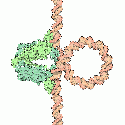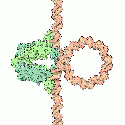Loop, de-loop
When conditions require it, a biological cell can prevent its machinery from reading a section of DNA by creating a loop—like the first loop you make when coiling a rope—just “upstream” from the gene to be suppressed. A repressor protein ties together two points on the DNA to make the loop. Researchers know a lot about the biochemistry of this kind of gene regulation but little about the physics.
Yih-Fan Chen, Joshua N. Milstein, and Jens-Christian Meiners, from the University of Michigan in Ann Arbor, US, have now shown experimentally that a miniscule amount of mechanical tension in the DNA strand can strongly affect the creation of the loop. They find that increasing the tension on the strand from to femtonewtons reduces the likelihood that a loop will form by a factor of ten, but once created, the loop is highly stable over the range of forces they tested.
The team used optical tweezers to tug on an -nanometer microsphere attached to one end of the DNA strand while the other end of the strand was stuck to the bottom of the water-filled chamber. The loop-binding protein LacI was in the solution, and the sphere height dropped whenever a DNA loop was created, shortening the free length of the strand.
Given the large effects of subpiconewton tensions, the authors suggest that cells may actively control DNA tension in order to protect the gene regulation process from even larger forces within the cell. Cells might even use tension to help regulate gene expression, they suggest, but there aren’t yet tools to measure such effects in living cells. – David Ehrenstein





